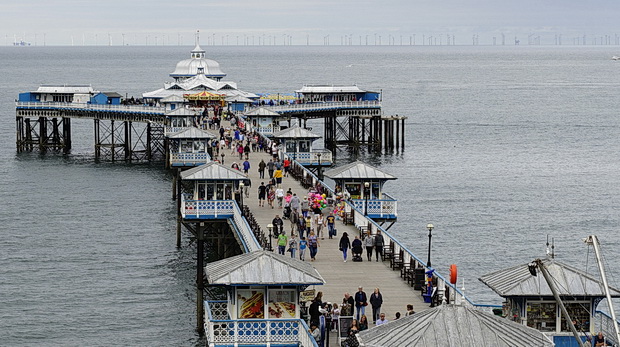
Wales’ longest pier with a length of 2,295 feet (700 m), Llandudno Pier is a Grade II listed structure that forms a major attraction in the seaside resort of Llandudno, North Wales.
Located on the coast of North Wales between Bangor and Colwyn Bay, the pier is unusual in having two entrances betwixt the Grand Hotel: one entrance is on the promenade at North Parade and the other, original entrance, is on Happy Valley Road.
Wikipedia details the history of the pier:
The pier had its origins in a much shorter pier of just 242 feet (74 m) built on 16 wooden piles, opened in 1858 by the St George’s Harbour and Railway Company, which had just completed its branch line from Llandudno to Conwy via a junction with the Chester and Holyhead Railway near the present Llandudno Junction railway station to which the branch was soon diverted.
That short pier was built to protect the rights of its owners to a much more ambitious scheme to build a major port in Llandudno Bay. Unfortunately, the pier was severely damaged in the Royal Charter Storm of 25 October 1859, which caused the loss of 223 ships and 800 people in British coastal waters. Although repaired and used for a further 16 years, the pier was too short and could only be used by steam ships at high tide.
The present pier, built for the Llandudno Pier Company by Walter Macfarlane of Glasgow using iron castings from the Glasgow Elmbank foundry, was opened to the public on 1 August 1877.
The landwards extension to the same design, still in deep water and also supported on iron columns, was opened in 1884 and a new landing stage was added in 1891. In 1969, the landing stage was totally rebuilt in concrete and steel, which enabled its use by the largest Isle of Man Steamers then in use. The wooden decking has been extensively renewed in recent years, and the superstructure is maintained systematically.
This website lavishes praise on the design
Commissioned by the Llandudno Pier Company, the design was by Charles Henry Driver in conjunction with James Brunlees, engineer.
The pier took just over a year to construct, opening to the public in 1878. The design of the pier is unusual in that instead of a normal straight neck projecting from the shore, Llandudno Pier has a 45-degree turn roughly a third of the way along its length.
Extending 1,234ft (376m) from shore the pier comprised initially of a promenade deck with a 60ft (18m) ‘T’ shaped pier-head, punctuated by four pairs of elegant kiosks along the neck, with a further three larger octagonal kiosks at the head.
Spectacular use was made of wrought iron in its decoration, especially in the delicate balustrades and lattice work railings.
The completion of the shoreward end of the complex was to take a further six years and comprised of a new pavilion that incorporated a swimming pool, and an extension past the Grand Hotel to the promenade that increased the pier’s overall length to 2,295ft (695m).
A landing stage was built in 1891 being reinforced in the early 20th century, and the surviving seaward end pavilion was added in 1905. Major alterations were made again to the landing stage in 1935.
A British Tourist Authority report in 1975 gushed about the pier’s beauty:
It zooms out of the sea all 1,400ft (424m) of it, in a spectacular Indian Gothic style rather like a Maharajah’s palace floating on a lake.
Cast iron, brackets of iron lacework, an outstandingly pretty balustrade like an enlarged fish net, ogee roofs curling away to the sky, all add up to a totally pleasurable experience.
At the end of the pier is a deep-water landing stage, completely rebuilt for the third time in 1969, which is used by the Isle of Man Steam Packet Company for occasional excursions to Douglas, Isle of Man, and for an annual visit of the PS Waverley or the MV Balmoral preserved steamers.
Fairground ride at the end of the pier, where there is also a cafe and bar.
Historic Views of Llandudno Pier
Llandudno Pier c.1880.
Located by the pier entrance was the Pavilion. Work started in 1881, but after major storm damage only opened in 1884.
It closed in 1984 and then suffered the very familiar tale of an arson attack, as this website explains:
In 1993 plans were being drawn up to restore the building and turn it into a “Covent Garden” type development that would include an element of Theatre along with shops, restaurants and exhibition and conference space.
However, the Pier Pavilion, which was a Grade II Listed building, became the victim of an arson attack in February 1994 which destroyed the building.
Nothing has replaced the Pavilion and only remnants of the cast iron supports and a staircase to the now lost exterior balcony remain.
The Pavilion with the pier in the distance.
Above is the remains of the Pier Pavilion today.
1895 postcard.
Late Victorian view.
Pier entrance, 1904.
Grand Hotel and pier, c1909.
Llandudno Pier in 1911.
Llandudno Pier in 1914.


